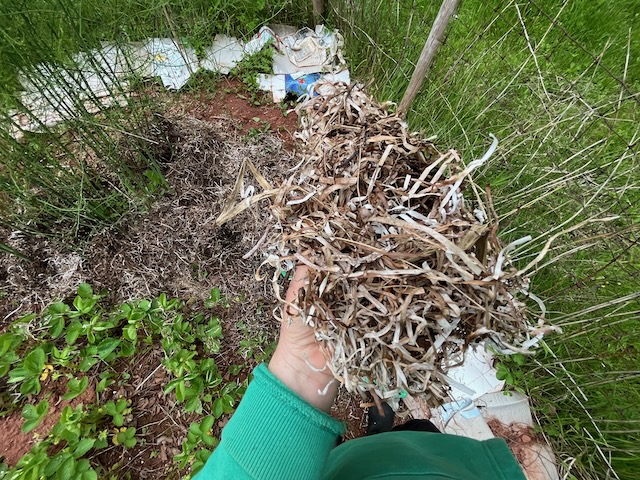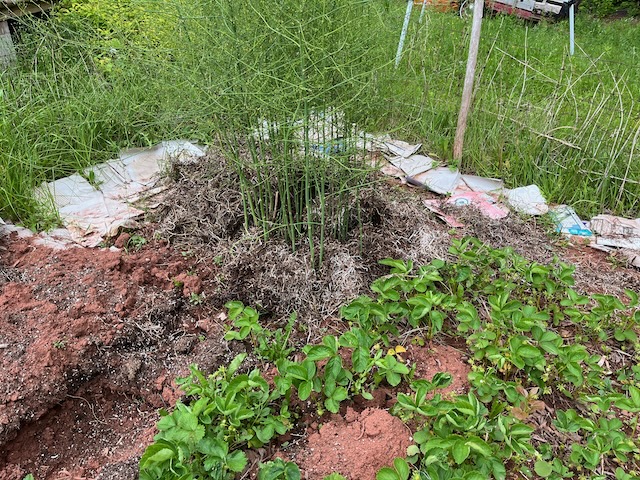My mother and I took a short detour on our way home after a recent appointment. I wanted to pick eelgrass from the shore to place around my tiny asparagus bed, a trick I learned from local master organic gardener Paul Offer, who generously taught an organic gardening course at our community school for many years. He said asparagus likes a little salt – it’s probably one of the few cultivated plants that does, I imagine – so some eelgrass scattered around suppresses weeds both by blocking light and from the trace of salt from the seawater in which it grows.
We drove down one of the many dirt roads that lead to the Conway Narrows, the body of water separating the mainland of PEI from the Conway Sandhills. I have written many times about the Sandhills, and my mother’s connection to them as possibly one of the last people to have lived there when, as a child in the 1920s and 30s, she spent every summer with her grandparents at their lobster cannery at Hardy’s Channel.
There are not many remote, wild places on PEI, but this is one of them. It is rare to see another human, except maybe an oyster fisher in a boat. During spring and fall migration it is common to see large flocks of geese and ducks as they move north or south.
I had forgotten to bring buckets with me, so I grabbed two grocery bins from my trunk and quickly filled them with the dried grass that a high tide had helpfully deposited on some wild rose bushes, so it had been well rinsed in the rain and then dried well in the sun and wind.
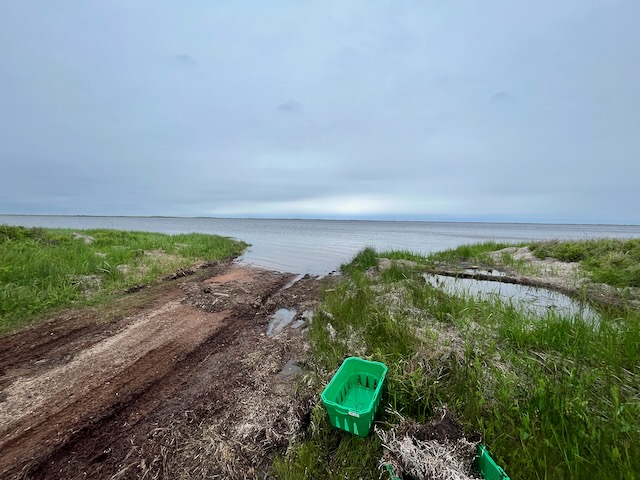
The quiet and calm of this place, the undulating dunes on the horizon, the absence of motorized anything, is a portal to another time. I was there at high tide, which prevents a walk as the beach is completely submerged, but at low tide you can walk a long way and see cranberry bogs and peatmoss hanging off the low bank, seabirds and shells and all sorts of treasures.
It is possible, in a couple of places, to walk through the water over to the Sandhills at low tide, but you really need to be aware of the weather and tides to do so, and it isn’t recommended unless you know what your doing. I’ve actually only done it once – we always boated over when I was a child – and it was a bit too wild, even for me!
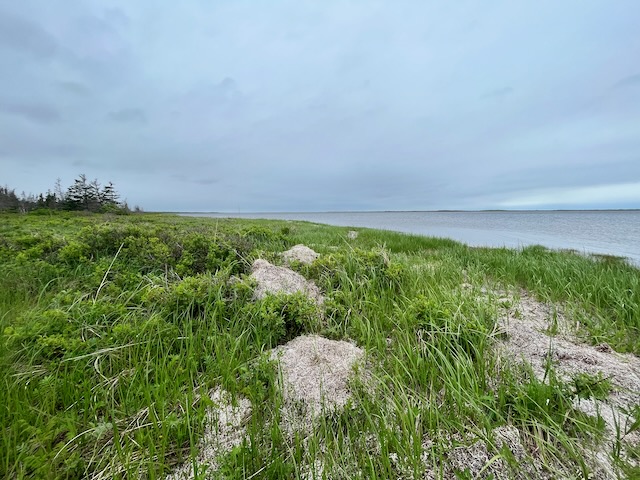
There was no time for wading or strolling anyway as my mother wanted to go see “Jimmy Mick’s place” while we were out that way. Jimmy MacDonald was a customer of my parent’s, a veteran of the First World War, long gone now. The electricity lines end at the intersection of the Luke and Murray Roads, and you keep following the later road, which is only really one lane at that point, to a turn the bend and there is Jimmy’s old house. It is in remarkably good shape for something that hasn’t been lived full-time in for decades, the roof line still straight, windows and doors intact. Someone has kept the grass cut around it. With the over-inflated PEI real estate market, even this ancient abode could now likely fetch more money than Jimmy ever made in his entire life.
We used to go out to Jimmy’s place to pick blueberries in the shrubby fields. The fields are all woodland now, and I doubt you could pick a cup of blueberries where once people could fill buckets. One of my mother’s great loves was picking wild berries, spending hours each summer gathering strawberries, raspberries and blueberries. I did not inherit the love of berry picking, and would dutifully accompany her and various great aunts when I was a child, but would only pick for a few minutes before wandering off to explore or head back to the car to read.
Our visit to the land of Jimmy Mick complete, we headed back home. The roads out there in the Black Banks (the blackness because of deposits of dark peat moss) are narrow and muddy in a few spots, and in a couple of swales I closed my eyes and gunned the car to get through, my mother and I laughing each time, well aware we could get stuck and relieved when we didn’t. We turned onto the Luke Road, a much better-kept route, but still narrow and muddy in places. We soon reached the pavement and drove in modern comfort the kilometer or so to our house.
You can still see a few older houses in our area ”banked” with dried eelgrass each fall. People collect truckloads of it and put it around the outside of the bottom of their house to keep out cold drafts in the winter, using stakes to keep it in place. Eelgrass was also used as insulation inside house walls a long time ago, which wasn’t really that effective, but better than nothing. My mother used to sleep on a straw tick mattress at the lobster cannery, and I bet you could throw some dry eelgrass in there, too, if it your mattress flattened and needed some bulk.
I remember learning to operate a dory with an outboard motor when I was about 8 and the feeling of the motor bogging down when I would steer into a shallow area and eelgrass wrapped around the propeller. I’d have to stop the boat, tip the motor up slightly, and then run it in reverse to clear the blades to continue on my way.
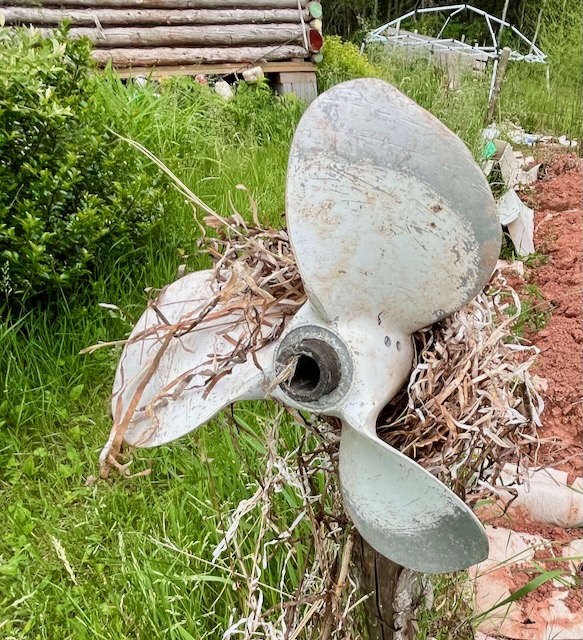
And yes, eelgrass is long and slithery like an eel, but there are also eels in eelgrass. When you learn to swim in a muddy-bottomed river, as I did, you get used to the silky feel of eelgrass brushing your legs as you move through it, and you sometimes feel an eel rush by, too, if you set your feet down in the wrong place. People who learned to swim in concrete pools or oceans usually find the river swimming experience unpleasant because of these encounters, and it probably is.
Lobsters live in eelgrass, too, and I would sometimes come face to face with them when I played Jacques Cousteau in the river as a child, each of us surprised to see the other, and both retreating in opposite directions. I never caught a lobster, as that’s both illegal without a license and pretty tricky with bare hands, but it was always fun to see them.
Eelgrass is under threat in some areas of the world, which is astonishing to me as it is such a ubiquitous part of my seascape, lots of it in the water just steps from our house. I will gather it as long as I can.
